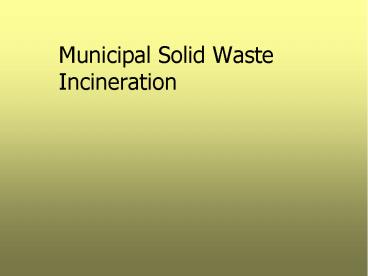Municipal Solid Waste Incineration - PowerPoint PPT Presentation
Title:
Municipal Solid Waste Incineration
Description:
Municipal Solid Waste Incineration Combustion Types Incineration (energy recovery through complete oxidation) Mass Burn Refuse Derived Fuel Pyrolysis Gasification ... – PowerPoint PPT presentation
Number of Views:148
Avg rating:3.0/5.0
Title: Municipal Solid Waste Incineration
1
Municipal Solid Waste Incineration
2
Combustion Types
- Incineration (energy recovery through complete
oxidation) - Mass Burn
- Refuse Derived Fuel
- Pyrolysis
- Gasification
- Plasma arc (advanced thermal conversion)
3
Gasification
- Partial oxidation process using air, pure oxygen,
oxygen enriched air, or steam - Carbon converted into syngas
- More flexible than incineration
- More public acceptance
4
Flexibility of Gasification
5
Pyrolysis
- Thermal degradation of carbonaceous materials
- Lower temperature than gasification
- Absence or limited oxygen
- Products are gas, liquid, solid char
- Distribution of products depends on temperature
6
Waste Incineration - Advantages
- Volume and weight reduced (approx. 90 vol. and
75 wt reduction) - Waste reduction is immediate, no long term
residency required - Destruction in seconds where LF requires 100s of
years - Incineration can be done at generation site
- Air discharges can be controlled
- Ash residue is usually non-putrescible, sterile,
inert - Small disposal area required
- Cost can be offset by heat recovery/ sale of
energy
7
Incineration
8
Environmental Considerations
- Tonne of waste creates 3.5 MW of energy (eq. to
300 kg of fuel oil) powers 70 homes - Biogenic portion of waste is considered CO2
neutral (tree uses more CO2 during its lifecycle
than released during combustion) - Should not displace recycling
9
Waste Incineration - Disadvantages
- High capital cost
- Skilled operators are required (particularly for
boiler operations) - Some materials are noncombustible
- Some material require supplemental fuel
- Public disapproval
- Risk imposed rather than voluntary
- Incineration will decrease property value
(perceived not necessarily true) - Distrust of government/industry ability to
regulate
10
Three Ts
- Time
- Temperature
- Turbulence
11
System Components
- Refuse receipt/storage
- Refuse feeding
- Grate system
- Air supply
- Furnace
- Boiler
12
(No Transcript)
13
Energy/Mass Balance
Energy Loss (Radiation)
Flue Gas
Waste
Mass Loss (unburned C in Ash)
14
Flue Gas Pollutants
- Particulates
- Acid Gases
- NOx
- CO
- Organic Hazardous Air Pollutants
- Metal Hazardous Air Pollutants
15
Particulates
- Solid
- Condensable
- Causes
- Too low of a comb T (incomplete comb)
- Insufficient oxygen or overabundant EA (too high
T) - Insufficient mixing or residence time
- Too much turbulence, entrainment of particulates
- Control
- Cyclones - not effective for removal of small
particulates - Electrostatic precipitator
- Fabric Filters (baghouses)
16
Metals
- Removed with particulates
- Mercury remains volatilized
- Tough to remove from flue gas
- Remove source or use activated carbon (along with
dioxins)
17
Acid Gases
- From Cl, S, N, Fl in refuse (in plastics,
textiles, rubber, yd waste, paper) - Uncontrolled incineration - 18-20 HCl with pH 2
- Acid gas scrubber (SO2, HCl, HFl) usually ahead
of ESP or baghouse - Wet scrubber
- Spray dryer
- Dry scrubber injectors
18
Nitrogen removal
- Source removal to avoid fuel NOx production
- T lt 1500 F to avoid thermal NOx
- Denox sytems - selective catalytic reaction via
injection of ammonia
19
Air Pollution Control
- Remove certain waste components
- Good Combustion Practices
- Emission Control Devices
20
Electrostatic Precipitator
21
Recovery of metals from Ash
- (Fe, Al, Cu, Zn, Cr, and Pb) concentrated in
bottom ash mostly, - while Cd existed primarily in fly ash.
- Fe, 2.69 102,
- Al, 1.46 104,
- Cu, 4.91 104,
- Zn, 6.92 101,
- Cr, 5.10 104,
- Pb 1.85 104
22
Ash
- Bottom Ash recovered from combustion chamber
- Heat Recovery Ash collected in the heat
recovery system (boiler, economizer, superheater) - Fly Ash Particulate matter removed prior to
sorbents - Air Pollution Control Residues usually combined
with fly ash - Combined Ash most US facilities
- combine all ashes
23
Schematic Presentation of Bottom Ash Treatment
24
Ash Reuse Options
- Construction fill
- Road construction
- Landfill daily cover
- Cement block production
- Treatment of acid mine drainage
25
Refuse Boiler
Fabric Filter
Stack
Spray Dryer
Tipping Floor
Ash Conveyer
Metal Recovery
Mass Burn Facility Pinellas County
26
Overhead Crane
27
(No Transcript)
28
(No Transcript)
29
Turbine Generator
30
Fabric Filter
31
(No Transcript)































